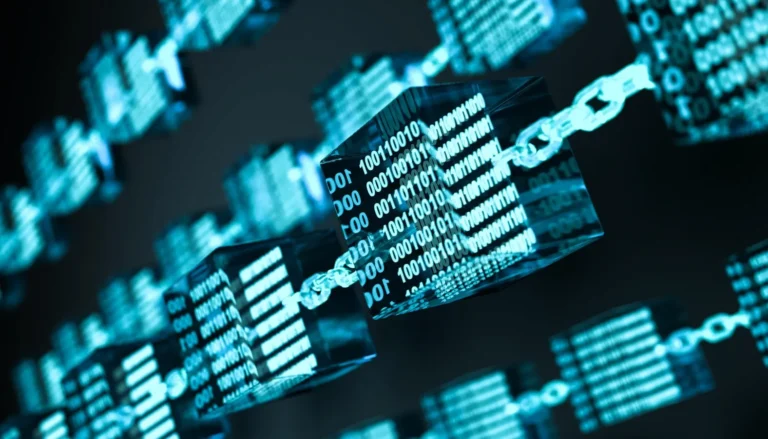The world of decentralized technologies is evolving at an unprecedented pace, driven by advancements in blockchain, smart contracts, cryptography, and decentralized applications (dApps). These innovations are not just refining existing frameworks but are also paving the way for a new era of decentralized solutions that can revolutionize industries ranging from finance to healthcare, gaming, and beyond.
As the decentralized web gains traction, technologies are becoming smarter, more efficient, and more scalable, addressing the challenges that previously held back mainstream adoption. This article delves into the latest advances in blockchain technology and decentralized applications, highlighting how these innovations are pushing the boundaries of what’s possible in the world of Web3.
Blockchain’s Evolution: From Proof of Work to Scalable Solutions
Blockchain, the backbone of decentralized tech, has already proven its value as a distributed ledger for cryptocurrencies like Bitcoin and Ethereum. However, scalability, energy consumption, and transaction speed have always been challenges. Recent innovations are focused on solving these problems, allowing blockchain to scale efficiently while keeping energy costs in check.
Proof of Stake (PoS) & Layer-2 Solutions: Scaling for the Future
One of the most significant updates in blockchain technology is the shift from Proof of Work (PoW) to Proof of Stake (PoS). Ethereum, the second-largest blockchain by market capitalization, successfully transitioned to PoS in late 2022 with Ethereum 2.0, a network upgrade designed to enhance scalability, security, and sustainability. Unlike PoW, which requires miners to solve complex mathematical puzzles (consuming vast amounts of energy), PoS allows users to “stake” their cryptocurrencies to validate transactions, drastically reducing energy usage.
In addition to PoS, Layer-2 solutions like Polygon and Optimism are making strides in improving scalability. These protocols are built on top of existing blockchains (like Ethereum) and handle transactions off-chain, processing them faster and at a lower cost while still benefiting from the security of the base blockchain. This combination of PoS and Layer-2 innovations ensures that decentralized networks can scale to meet global demand without compromising on decentralization.
Smart Contracts: Automation Meets Blockchain
Smart contracts are self-executing contracts with the terms of the agreement directly written into code. They run on blockchain platforms like Ethereum and allow for automation of complex processes, eliminating the need for intermediaries. While smart contracts have been around for a while, recent advancements have expanded their capabilities, making them smarter, more flexible, and more secure.
Improving Contract Language: Solidity and Beyond
One of the key innovations in smart contracts is the development of more intuitive and secure programming languages. Solidity, the primary language used to write Ethereum smart contracts, has evolved with additional features and improvements to enhance developer experience and security. Furthermore, new languages like Vyper and Rust (used in blockchains like Solana and Polkadot) are providing more options for developers, each offering specific advantages in terms of security, performance, and ease of use.
These advancements are enabling more complex use cases, such as decentralized finance (DeFi), NFTs, and DAO governance, while reducing the risks of bugs or vulnerabilities in contract code. With better language features and enhanced tooling, smart contracts are becoming a powerful tool for automating everything from financial transactions to supply chain management and even gaming economies.
Cross-Chain Interoperability: Bridging Blockchain Ecosystems
As the blockchain ecosystem expands, cross-chain interoperability has become a focal point of innovation. The ability for different blockchain networks to communicate and share data seamlessly is essential for achieving a truly decentralized and connected digital ecosystem.
Projects like Polkadot, Cosmos, and Chainlink are leading the way in interoperability, allowing for the exchange of data and value across different blockchain platforms. This cross-chain communication enhances the functionality of dApps by enabling them to interact with multiple blockchains simultaneously, unlocking new possibilities for decentralized finance, asset management, and decentralized autonomous organizations (DAOs).
These interoperability solutions are vital for unlocking the full potential of Web3, enabling users and developers to tap into the strengths of different blockchains while overcoming the limitations of siloed ecosystems.
dApps: Decentralizing the User Experience
At the heart of Web3 are decentralized applications (dApps)—software applications that run on a blockchain network rather than being hosted on centralized servers. dApps are central to the promise of decentralization, offering users greater privacy, control, and security over their data and assets.
While dApps have existed for years, they are now reaching new levels of sophistication. Recent updates focus on improving user experience (UX), scalability, and security—areas where traditional apps often fall short when compared to their centralized counterparts.
Improved User Interfaces: Making Decentralization Accessible
One of the most significant barriers to mass adoption of dApps has been their complexity. Using a decentralized application often requires users to interact with wallets, understand gas fees, and navigate the intricacies of blockchain-based systems. However, the latest innovations in user interface (UI) and user experience (UX) design are making dApps more intuitive and accessible to mainstream users.
For example, wallet providers like MetaMask and Trust Wallet have made it easier for users to interact with decentralized applications through simple, intuitive interfaces that abstract away the technical complexities. Likewise, dApp developers are increasingly focusing on creating mobile-friendly applications that provide users with smooth, seamless experiences akin to traditional web or mobile apps.
Scalable dApps: From Gaming to Finance
Gaming and finance are two areas where dApps are seeing massive growth. Play-to-earn (P2E) games, which allow users to earn cryptocurrency and NFTs by participating in in-game activities, are becoming increasingly popular. Projects like Axie Infinity, Decentraland, and The Sandbox have already built thriving decentralized economies powered by blockchain and NFTs, and newer platforms are improving scalability to handle millions of concurrent players.
In decentralized finance (DeFi), smart contract-driven platforms allow users to access lending, borrowing, staking, and yield farming services without intermediaries. The rise of layer-2 scaling solutions like Arbitrum and Optimism is making these DeFi dApps faster and more affordable to use, making them more attractive to mainstream users and institutions alike.
The Future of Decentralized Tech
As blockchain, smart contracts, and dApps continue to evolve, they are expected to play an even greater role in transforming industries and society at large. The focus on scalability, security, and interoperability is crucial for creating the infrastructure needed to support a decentralized internet, where individuals have full control over their data, assets, and digital identities.
Key areas to watch for the future include:
- Zero-Knowledge Proofs (ZKPs): These cryptographic methods enable the verification of information without revealing the underlying data, enhancing privacy in blockchain transactions.
- Decentralized Identity (DID): This technology will empower individuals to own and control their identity, reducing reliance on centralized authorities like governments or social media platforms.
- Web3 Adoption: As more businesses, governments, and users embrace Web3 technologies, we can expect the ecosystem to expand and mature, leading to broader adoption of decentralized platforms.
Conclusion: Smarter, More Scalable Decentralization
The world of decentralized technology is rapidly advancing, with blockchain, smart contracts, and dApps becoming smarter, more efficient, and scalable. Innovations such as PoS, Layer-2 solutions, and cross-chain interoperability are addressing the pain points of previous generations of blockchain technology, paving the way for more mainstream adoption.
As the decentralized web matures, it promises to offer a more secure, transparent, and user-centric internet—one where individuals have more control over their digital lives. The continued innovation in decentralized technologies holds immense potential for reshaping industries, empowering users, and unlocking new opportunities for creators, developers, and businesses alike.
With each technological breakthrough, decentralized tech is becoming smarter, more powerful, and more accessible—ushering in the next era of the internet.






